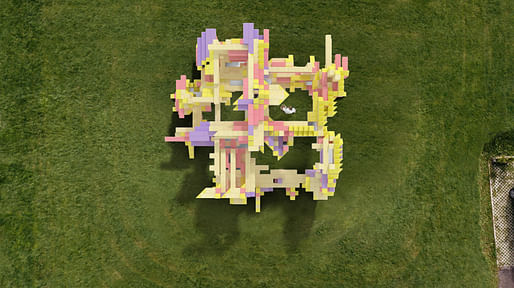
The hot new trend sweeping the art and design communities will be at the center of next year’s Tallinn Architecture Biennale. The festival released its 2022 list of exhibitors on Thursday, which includes an installation program highlighted by a virtual metaverse space from the web-based studio iheartblob.
Touted as the world’s first-ever blockchain-funded pavilion, the installation "Fungible Non-Fungible Pavilion" has a specific focus on the concept of slowness similar to the overall theme of the biennial, which this year is “Edible; Or, the Architecture of Metabolism.”
The installation was named the de-facto winner of this year’s installation competition after another exhibitor, the fungi-inspired team called Simulaa (previously on Archinect), dropped out due to unforeseen circumstances. iheartblob nonetheless won for its crowdfunded and sourced entry that they say will empower local communities towards craftsmanship in specifically AI and NFT-based hybrid digital-physical design builds.

According to the studio: “The integration of such technologies enables the design of a pavilion that evolves and grows both physically and digitally. Furthermore iheartblob, rather than designing architecture elements themselves, have built an NFT-generative tool in which individuals can design and 'mint' — the process of creating and authenticating digital ownership — their own objects. As part of their NFT-generative tool, a parametric setup is provided for users to design within constraints (e.g. grid systems, predefined interlocking components, timber materiality, etc.). The initial minting fee can therefore be calculated to cover the budgeted costs of material and overheads (labor, fabrication, etc.), and a physical object manifests from digital design. In essence, every NFT minted by their tool funds a physical twin that is used in the pavilion. The digital objects can then be sold, by the owners, on secondary marketplaces as a way for the community designers to generate returns on their design/investment.”
The end result is a compartmentalized design that is owned by their individual makers and reflective of the specific community writ large.
An application will be available for those wishing to contribute to the group’s design beginning May 1st and remain open until the beginning of July. The installation will go on view in front of the Museum of Estonian Architecture when the Biennale opens on September 7th and remain in place until its next edition in 2024.
4 Comments
Nothing about NFT-related design projects so far really does anything new other than their blurb. Its either low-res copies of designs that would not have been any different without NFTs, or verbose descriptions to hype up the NFT aspect without any corresponding architectural feature that is uniquely NFT-driven.
The worst offenders are those who dust off an old project for a press release hashtagging all the right buzzwords.
This one tries, but the form generation and process looks like something from Sci Arc 101.
Safdie called and he wants Habitat 67 back
My kid wants his Legos back!
I agree that this structure is the result of design by community.
Block this user
Are you sure you want to block this user and hide all related comments throughout the site?
Archinect
This is your first comment on Archinect. Your comment will be visible once approved.